Wikipedia:Picture of the day/June 2008
|
Featured picture tools: |
These featured pictures, as scheduled below, appeared as the picture of the day (POTD) on the English Wikipedia's Main Page in June 2008. Individual sections for each day on this page can be linked to with the day number as the anchor name (e.g. [[Wikipedia:Picture of the day/June 2008#1]] for June 1).
You can add an automatically updating POTD template to your user page using {{Pic of the day}} (version with blurb) or {{POTD}} (version without blurb). For instructions on how to make custom POTD layouts, see Wikipedia:Picture of the day.
June 1

|
After being forced to leave the Philippines after the Japanese victory in 1942, General Douglas MacArthur vowed, "I shall return." 31 months later, he waded ashore at Palo Beach at the outset of the Battle of Leyte, fulfilling his pledge as the United States retook the island. Photo credit: United States Army
Recently featured:
|
June 2

|
Broadbarred firefish (Pterois antennata) in Schönbrunn Zoo, Vienna, Austria. Pterois is a genus of marine fish found mostly in the Indo-Pacific. Scorpionfish is another common name of Pterois, as its spines are venomous. Photo credit: Christian Mehlführer
Recently featured:
|
June 3

|
An American Medium Tank M3, commonly called the "General Lee" (after Robert E. Lee) in Britain, on training exercises at Fort Knox, Kentucky in June, 1942. At the outset of World War II, the M3 was developed as an interim solution to replace the outdated M2, before the M4 Sherman could be mass-produced. A slightly different model was known as the "General Grant" (after Ulysses S. Grant). Photo credit: Alfred T. Palmer, FSA-OWI
Recently featured:
|
June 4

|
The Eastern Bearded Dragon (Pogona barbata) is a lizard found in wooded parts of Australia. It is a large species of grey-black colour distinguished from its relative, the Central Bearded Dragon, by its less robust body and the row of spines along the lateral edge of the body, which continues over the forearm. It has an adult snout-tail length of about 60 cm (24 in). Photo credit: John O'Neill
Recently featured:
|
June 5

|
|
An 1851 daguerreotype of Portsmouth Square, San Francisco, California. Now a one-block square in Chinatown, it is located on the site of the first public square established in Yerba Buena, the Mexican community that became San Francisco. It is named after the USS Portsmouth, which raised the American flag here at the onset of the Mexican–American War. Daguerreotype credit: Unknown
Recently featured:
|
June 6
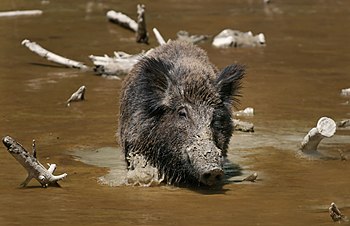
|
A wild boar (Sus scrofa), shown here in an animal sanctuary, the wild ancestor of the domestic pig. Boars are native across much of Central Europe, the Mediterranean Region and much of Asia. Wild boars almost always have thick, short bristly coats ranging in colour from brown through grey to black. Photo credit: Richard Bartz
Recently featured:
|
June 7

|
A male Leopard Lacewing (Cethosia cyane), a species of heliconiine butterfly found in South Asia. Photo credit: Airbete
Recently featured:
|
June 8

|
An adult Dunlin (Calidris alpina) in breeding plumage. This bird is one of the most common and best-known waders throughout its breeding and wintering ranges, and it is the species with which other waders tend to be compared. Photo credit: Mdf
Recently featured:
|
June 9
|
This true-color image, taken by the Mars Exploration Rover Opportunity, shows the Victoria Crater from Cape Verde, Mars. Cape St. Vincent is the promontory visible on the left of the photo. On the right is Duck Bay, and beyond that, on the inner crater wall, is the north face of the 15 meter (50 foot)-tall stack of layered rocks called Cabo Frio. Photo credit: Opportunity rover
Recently featured:
|
June 10

|
Infantrymen of the 255th Infantry Regiment move down a street in Waldenburg, Baden-Württemberg, Germany, searching for a fugitive after a recent raid by the 63rd Infantry Division in 1945. Photo credit: 2d Lt. Jacob Harris, U.S. Army
Recently featured:
|
June 11

|
|
A daguerreotype of the United States Capitol in 1846, with the original green copper dome as designed by Charles Bulfinch. Over time, extensions to both the north and south wings, made to accommodate the addition of new states to the Union, made the dome aesthetically displeasing, and as a result, it was replaced by a white cast iron dome which was completed in 1866. Daguerreotype credit: John Plumbe
Recently featured:
|
June 12

|
A collage of six mustard images: Seeds of the mustard plant (top left) may be ground (top right) to make different kinds of mustard. The four mustards pictured are a simple table mustard with turmeric coloring (center left), a Bavarian sweet mustard (center right), a Dijon mustard (lower left), and a rough French mustard made mainly from black mustard seeds (lower right). Image credit: Rainer Zenz
Recently featured:
|
June 13
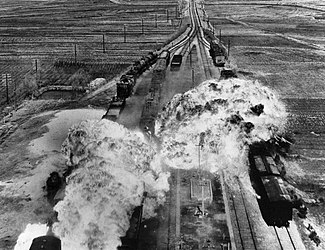
|
United States Army forces target railway cars south of Wonsan, North Korea, an east coast port city, during the Korean War. Trains in North Korea were targets of attack by U.S. and other U.N. forces, so much so that both military and civilian trains often had to wait out the daylight hours in tunnels. Photo credit: United States Army
Recently featured:
|
June 14
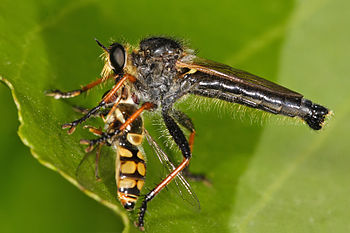
|
A Common Brown Robber fly (Zosteria sp.), one of the 7,100 described species of robber flies, shown here feeding on a hoverfly. Adult robber flies attack other flies, beetles, butterflies and moths, various bees, dragon and damselflies, ichneumon wasps, grasshoppers, and some spiders. Photo credit: Fir0002
Recently featured:
|
June 15
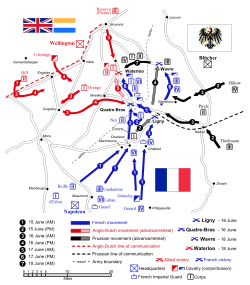
|
A map of troop movements during the Waterloo Campaign, leading up to the Battle of Waterloo where Napoleon Bonaparte was defeated. Napoleon's Army of the North came up against a coalition army composed of forces from the United Kingdom, the Netherlands, Prussia, Hanover, Nassau, and Brunswick. Beginning 15 June 1815, the combatants fought successively in the Battle of Quatre Bras, the Battle of Ligny, the Battle of Waterloo, and lastly the Battle of Wavre. Map credit: Gsl/I. Pankonin
Recently featured:
|
June 16

|
Diagram showing the appearances and relative sizes of 18 basal species of Ceratopsians (frilled, beaked dinosaurs typified by Triceratops). Animals are shown in order of geologic stage from left to right and top to bottom, with species names and stage information as annotation. Ceratopsians were beaked herbivores who lived in what are now North America and Asia, during the Cretaceous Period. Early members such as Psittacosaurus were small and bipedal. Later members, including ceratopsids like Centrosaurus and Triceratops, became very large quadrupeds and developed elaborate facial horns and a neck frill. Image credit: ArthurWeasley
Recently featured:
|
June 17

|
The 71st plate from German biologist Ernst Haeckel's Kunstformen der Natur, showing radiolarians of the order Stephoidea. Radiolarians form intricate mineral skeletons, usually with a central capsule dividing the cell into inner and outer portions. Radiolarians are found as zooplankton throughout the ocean and are important diagnostic fossils, found from the Cambrian period onwards. Image credit: Ernst Haeckel
Recently featured:
|
June 18

|
A Canada Goose (Branta canadensis) looking for food on a partially frozen pond in Massachusetts. This species is native to North America. It breeds in Canada and the northern United States in a variety of habitats. Canada Geese are also found naturally on the Kamchatka Peninsula in eastern Siberia, eastern China, and throughout Japan. They have reached northern Europe naturally, as has been proved by ringing recoveries. Photo credit: Eric Baetscher
Recently featured:
|
June 19

|
Peyto Lake, located in Banff National Park in the Canadian province of Alberta, as seen from a viewpoint at Icefields Parkway. The turquoise colour is caused by rock flour found in glacier meltwater. Photo credit: Tobias Alt
Recently featured:
|
June 20

|
Ukrainian fashion model Nataliya Gotsiy modeling for Cynthia Rowley, Spring 2007 New York Fashion Week. She was the winner of the Ford Supermodel of the World 2004 search. She has appeared on the cover of French Elle and Italian Marie Claire and modeled for Behnaz Sarafpour, Christian Lacroix, Diane von Furstenberg, Dior, Dolce & Gabbana, Dries van Noten, Gucci, Oscar de la Renta, Valentino, and Vivienne Westwood, among others. Photo credit: Peter Duhon
Recently featured:
|
June 21
|
A panorama of Upernavik, Greenland, a small town in the Arctic Circle. The series of photos was taken at 23:50 (11:50 PM) local time, showing the midnight sun. Upernavik (pop. 1140) is a town in the Upernavik district, which covers an area comparable to the United Kingdom but has only 3,000 inhabitants. With a population density of only 0.015 persons/km², the district is one of the least populated areas of the world. Photo credit: Kim Hansen
Recently featured:
|
June 22

|
Lilium 'Citronella', a lily cultivar (as indicated by the name being in single quotation marks). Lilies are herbaceous flowering plants normally growing from bulbs. Although the common name "lily" is applied to other related plants, only those in the Lilium genus are considered "true lilies". Photo credit: Derek Ramsey/Chanticleer Garden
Recently featured:
|
June 23

|
The Australian painted lady (Vanessa kershawi) butterfly is found in both Australia and New Zealand. It is similar to the near-cosmopolitan Painted Lady V. cardui and is sometimes considered a subspecies of that butterfly. Photo credit: Fir0002
Recently featured:
|
June 24
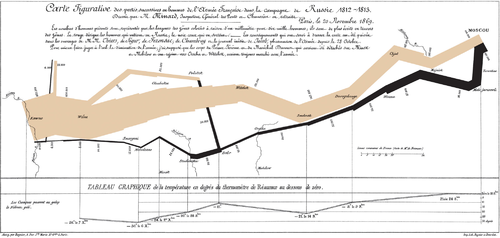
|
|
Charles Minard's Carte figurative (1869), which details the losses of men, the position of the army, and the freezing temperatures on Napoleon's disastrous 1812 invasion of Russia. Created in an effort to show the horrors of war, the graph "defies the pen of the historian in its brutal eloquence" and has been called the best statistical graphic ever drawn. Image credit: Charles Joseph Minard
Recently featured:
|
June 25
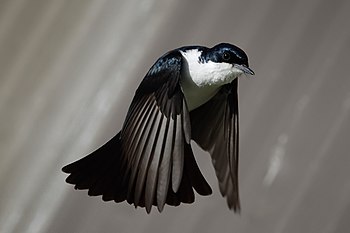
|
A Restless Flycatcher (Myiagra inquieta) in flight. This passerine bird is found in Australia and Papua New Guinea. It is about 20 cm (8 in) long, with a glossy dark blue crown, a grey back and white underparts. It is similar to the Willie Wagtail, though the lack of a black throat & white eyebrow are distinguishing features. Its main food is insects. Photo credit: Fir0002
Recently featured:
|
June 26
|
A newsreel showing the breaking of the sound barrier on 14 October 1947 by Chuck Yeager in the rocket-powered Bell X-1. Flying at an altitude of 45,000 ft (13.7 km), Yeager became the first person to break the sound barrier in level flight. Film credit: United States Air Force
Recently featured:
|
June 27

|
The Mice Galaxies, NGC 4676A (right) and NGC 4676B (left), are two spiral galaxies in the constellation Coma Berenices that are presently in the process of colliding and merging. Their name refers to the long tails produced by galactic tides. Photo credit: Hubble Space Telescope
Recently featured:
|
June 28
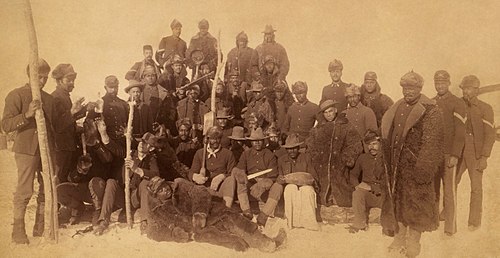
|
|
Buffalo Soldiers of the United States Army's 25th Infantry, some wearing buffalo robes, Fort Keogh, Montana, 1890. Although the origin of the name is uncertain, the term Buffalo Soldiers became a generic term for all African American soldiers. It is now used for U.S. Army units that trace their direct lineage back to the 9th and 10th Cavalry. Photo credit: Chr. Barthelmess
Recently featured:
|
June 29

|
A racist political campaign poster from the 1866 Pennsylvania gubernatorial election. The poster specifically characterizes Democratic candidate Hiester Clymer's white supremacist platform as "for the White Man," represented here by the idealized head of a young man. In contrast, a stereotyped black head represents Clymer's opponent John W. Geary's platform, "for the Negro." Poster credit: Unknown
Recently featured:
|
June 30

|
The "Double O Arch", a natural sandstone arch in Arches National Park in Utah, United States. This is one of over 2,000 natural arches found in the park and is so named because there are two arches that form circular holes: the easily visible large one, and the smaller hole underneath it. Photo credit: Flicka
Recently featured:
|
Picture of the day archives and future dates


